Australian heritage engineering record. 45 p., [41] leaves of plates : ill., ports. ; 25 cm. #1020 Water-supply — Western Australia — Perth Metropolitan Area — History.The first European settlers who came to Perth in 1829 relied on swamps, lakes, rainwater tanks and a few freshwater springs for their water supplies. Early colonists also used wells in Perth and Fremantle. When population started to rapidly increase in the late 1800s due to the gold rushes, summer water shortages and pollution in the wells resulted in disease such as typhoid, and the need for a safe public water supply became urgent. As there was disagreement between the Town Councils and the Colonial Government about responsibility for public water supply, a number of private proposals were developed by entrepreneurs in the community. One of these proposals, based on a dam on Munday Brook in the “hills”, was prepared by Perth civil engineers Henry John Saunders and James Barratt in May 1887. Following the Government’s rejection of funding assistance in August 1889, Perth City Council awarded a build, own and operate contract to a Melbourne contractor Neil McNeil and Co on 21 October 1889. Neil McNeil and Co was represented in Perth by Edward Keane and their successful tender was based on the proposal prepared by Saunders and Barratt. Saunders and Barratt’s proposed water supply scheme included a new source of 140,000,000 gallons storage located in the Darling Range east of Perth, 16¾ miles of 12 inch trunk main, a 1,260,000 gallon service reservoir at Mt Eliza and city reticulation. Site clearing commenced in October 1889 and the site was ready by the time cement and pipes started to arrive four months later from England. When Victoria Reservoir was opened on 1 October 1891, the rapidly growing State’s population was less than 50,000 and Perth’s first public water supply scheme was a major undertaking. After 99 years of service, a portion of the original Victoria Reservoir wall was demolished and a new Victoria Dam built 300 metres upstream. The original dam is accessible by public walk trails and traces of the original cast iron gravity trunk main, such as concrete pipe supports, still exist. The service reservoir at Mt Eliza has been replaced with significantly larger reservoirs, but the site is still a key operational site supplying the City of Perth today. Perth’s first public water supply scheme is significant in that it allowed Perth to grow in response to the State’s gold rush and was the predecessor for the major Coolgardie Goldfields Water Supply Scheme. Engineering and construction of the scheme was “best practice” and was the model used for many of Perth’s subsequent “hills” water supply sources. Management of the scheme was controversial due to unprecedented rapid growth in demand and deterioration in the quality of the water due to timber mill camps in the catchment, issues that are still relevant for water supply authorities today. In the end, the privately owned City of Perth Water Supply Company’s 25 year contract was bought out early by Government. The first of many subsequent public boards of management was appointed on 5 October 1896. (Bookplate inside cover.)
Perth’s Early Water Supplies
$50.00
Sold Out
Additional Information
| Author | Hunt, H. E. |
|---|---|
| Publisher | Perth [W.A.] : W.A. Division, Institution of Engin |
| Year Published | 1984 |
| Book Condition | Near Fine |
|---|---|
| Binding Type | Softcover |
